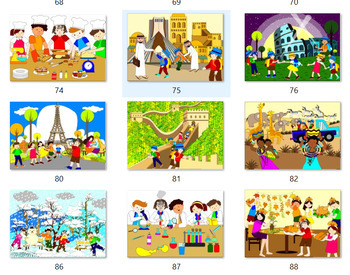MEGA MEGA BUNDLE BIG SCENES, colouring scenes themes speech therapy puzzles ABA
- Zip
Products in this Bundle (24)
showing 1-5 of 24 products
Description
Your students will LOVE these engaging picture scenes, and you will love the versatility of using them to address your students’ speech and language goals!
Each scene has a beautiful illustration. You will meet the same group of beautiful children but they are doing different activities in each scene. This is my own idea, and for sure you have never seen any material like that before.
Picture scenes are a versatile and engaging tool to use in speech therapy. You can use them to teach your students vocabulary, sentence formulation, WH questions, comparing/contrasting, giving directions, defining/describing, making predictions, and explaining similarities and differences.
These picture scenes are great for mixed groups, substitute lesson plans, language sampling, progress monitoring, storytelling, and articulation carryover!
Print or no print! You decide!
These picture scenes can be presented to students on a laptop/computer screen or on a tablet. You will need to have a PDF reader on whichever device you choose. There are many details to talk about in each picture scene, so different language structures and content can be elicited to address your students’ language goals. If you choose to print the pictures, print on card stock and laminate for durability.
HOW TO USE PICTURE SCENES IN SPEECH THERAPY
CONVERSATIONS
I love to use scenes to work on conversational turn-taking or initiating conversations. Present your student (or let them choose) a picture and have them start a conversation based on it. You may also see how many times you, or two students, can go back and forth with questions/comments about the picture.
VOCABULARY
Many of these scenes have a theme. Use these themes to teach vocabulary and discuss associations, categories, and negation.
VERBS
All of these scenes are packed with people doing things. This makes them perfect to talk verbs – present, past, or present progressive. I like to use these scenes as a generalization tool for this instead of the beginning stages of teaching verbs. Use the scenes to point to a character and ask: What is she doing? What did he do? What do you think they are going to do?
WH QUESTIONS
Use the scenes to work on answering various questions correctly: Who is that? What is that? Why is he happy? Where is the bird? When do you use an umbrella? It’s easy to come up with different types of WH question to ask with the variety of scenes and many things happening in each one.
SENTENCE FORMULATION
Have your student work on sentence formulation with an engaging scene of their choice. Ask them to describe something they see. If needed, prompt your student with a more specific question, such as: Tell me what the girl did. Use a sentence scaffold to focus the sentences on including something specific, for example, pronouns or past tense verbs. (eg. He/she + is + -ing.)
FOLLOWING DIRECTIONS
Give simple 1-step directions or complex multi-step directions! For example, “Point to the car” or “Touch the girl with pink dress, then find the boy singing, and last point to the smallest apple”.
INFERENCES
These fun scenes are great for making inferences. Why do they wear jackets? Why are the kids laughing? Why is she crying?
NOUNS & PRONOUNS
Since these pictures are packed with people, it’s easy to work on nouns (boy, girl) and pronouns (he, she, they, his, hers, theirs). Ask: Who is that? Who is sleeping? Whose toy is it?
PREPOSITIONS
Discuss where the scenes are: outside, inside, at the park. You may also test generalization skills of various prepositions: in, on, under, near, far, between, in front, between, above, below or prepositional phrases.





